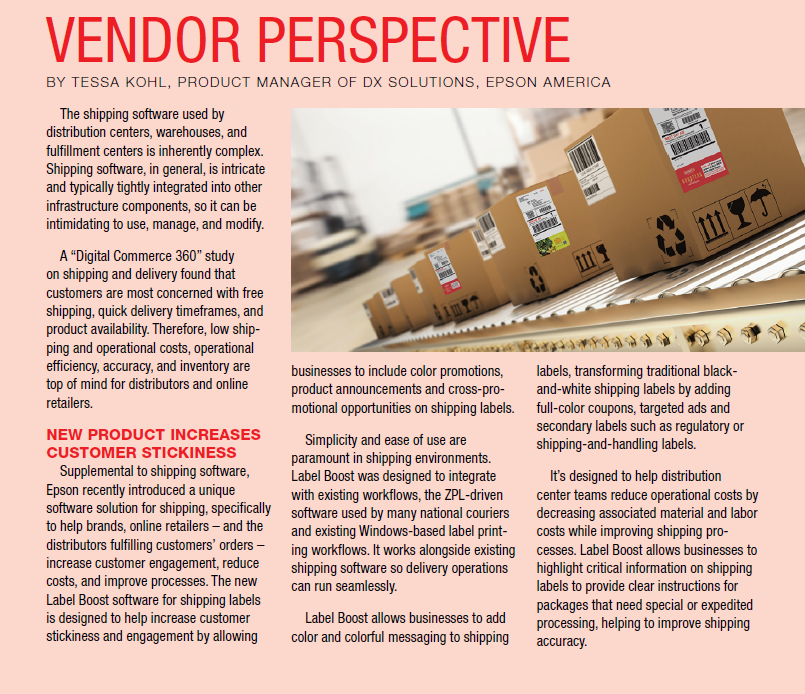Navigating the Seas of Shipping Software
 |
| istockphoto.com |
A comprehensive guide for choosing well.
by Rachael Radford
Main functionality. Shipping software supports order management systems that handle large volumes of shipments efficiently. Multi-carrier support allows for the comparison of rates and services. Automation capabilities reduce manual intervention and errors. Advanced tracking and visibility tools in the system offer real-time updates on shipment status, and robust reporting and analytics provide valuable insights for continuous improvement.
Key benefits. Shipping software significantly enhances operational efficiency, reduces shipping costs through optimized carrier selection, and improves customer satisfaction with accurate and timely delivery information. Shipping software stands as a cornerstone for modern, efficient, and responsive supply chain management by ensuring compliance with shipping regulations and offering seamless integration with existing enterprise systems like ERP and WMS.
TYPES OF SHIPPING SOFTWARE
“Shipping software” actually covers a broad range of tools designed to cater to specific shipping needs within the shipping and logistics process. Common types of shipping software include:
1 Shipping Management Platforms. This consists of comprehensive systems designed to oversee and manage the entire shipping process, including order fulfillment, carrier selection, label printing, and tracking. They often integrate with other business systems, such as e-commerce platforms and warehouse management systems, for a seamless workflow.
2 Multi-carrier Shipping Software. This is a specialized system supporting multiple shipping carriers, enabling businesses to compare rates, services, and delivery times from multiple carriers to help the business select the best suited shipping options.
3 Warehouse Management Systems (WMS). This may not technically be considered a shipping software, but WMS often includes shipping functionalities such as order fulfillment and inventory management. You may be able to use one WMS system instead of two separate systems, depending on the complexity of your process and data.
4 Transportation Management Systems (TMS). This focuses on the planning, execution, and optimization of freight transportation processes. This software helps businesses manage transportation fleets, select carriers, and track shipments to improve logistics efficiency and reduce costs.
5 Parcel Auditing Software, Shipping Label Software, Address Validation Software. These are specialized tools designed to cater to specific aspects of the shipping process, such as auditing invoices, generating shipping labels, and verifying addresses. They ensure accuracy and find discrepancies to improve efficiency, reduce costs, and enhance overall supply chain management.
KEY FEATURES TO LOOK FOR
When selecting shipping software, it’s crucial to identify the processes you need this software to support and how. Software is meant to support the business process through automation, bringing in best practices and standardizing business functions. But to see a return, you’ll need to be clear on your expectations and be able to communicate them to the vendor effectively.
Depending on your requirements, you may need the following functionality:
- Barcoding Integration: Facilitates accurate and efficient tracking of shipments throughout the logistics chain, improving inventory management and order fulfillment.
- Shipping Labels: Generates compliant and clear shipping labels to ensure seamless communication with carriers and minimizes delays in delivery.
- Multi-Carrier Support and Rate Comparison: Facilitates comparison of rates and services across multiple carriers, ensuring cost-effective and reliable shipping options.
- Invoicing Capabilities: Creates and manages shipping invoices with multiple formats, customizable billing rules, and details, integrating with financial systems.
- Pallet Building: Designs optimal pallets for shipping and ensures pallets can safely carry the intended load while minimizing cost.
- Security and Compliance Features: Ensures data security through encryption and compliance with industry regulations, safeguarding sensitive information.
- Automation Capabilities: Automates repetitive tasks to streamline processes, save time and reduce errors from order processing to label generation.
KEY CONSIDERATIONS
When selecting new software, you want to assess your current systems and processes. It is important to understand what is working well, so you can ensure the new software can maintain or support what works while bringing additional benefits.
It is equally critical to understand what areas are lacking to ensure the new technology can close the gap. This assessment will help you determine what your most critical requirements are:
Note: You will never find a piece of software that can do absolutely everything, so it’s key to know what requirements are critical versus nice to have.
Below are some of the main questions that can help uncover your current state and key requirements:
- Scope of Operations: Where are you shipping to? Are you serving markets locally, nationally, or internationally? How many warehouses do you ship from?
- Type of Shipping: Do you require an aggregator to consolidate many shipments into one? Do you do LTL and/or FTL shipping? Do you want to offer COD (cash on delivery) shipping?
- Integration Needs: Does the existing software seamlessly integrate with your existing systems, such as e-commerce platforms, Enterprise Resource Planning (ERP) or warehousing management systems? If not, does it need to? If so, what integration options have successfully worked for past clients?
- Carrier Partnerships: Some shipping software platforms offer exclusive deals with specific carriers, providing access to discounted shipping rates. Assessing which carriers the software collaborates with and whether they align with your current partners is essential.
- Scalability and Cost: Can the software accommodate your growing shipping volume, and how does the cost factor into your overheads?
- Cross-Border Needs: Are customs or duties relevant to your products? Do you need to work with a customs broker?
- Customer Service: What does your customer journey look like? Do customers need tracking numbers, or live shipping updates? How are you communicating shipping-related information to your customers?
- Shipping Costs/Rates: Do you offer customers set shipping rates, or do you need to provide quotes? Do you pass shipping costs to the customer at cost, or do you have a markup?
- Other Functionality Needs: How are you managing packaging? Do you need to manage returns, or offer shipping insurance?
 |
UNDERSTANDING LTL AND FTL SHIPPING
If you ship goods heavier than 150 pounds, understanding the differences between Less Than Truckload (LTL) and Full Truckload (FTL) shipping is crucial when selecting the best-suited shipping software for your business.
LTL Shipping. This ships small- to medium-sized pallet loads, using only a portion of the truck trailer and allowing multiple shippers to share the same truck space. LTL requires meticulous attention to size, weight, and dimensions for accurate pricing calculations. This method is cost-effective for smaller shipments that do not require an entire truck. It can result in longer transit times due to multiple stops and handling points, which also poses an increased shortage risk.
FTL Shipping. This utilizes the entire truck for a single shipment and is better suited for larger shipments that warrant dedicated truck space and require direct transportation. This method offers faster transit times and less handling, leading to the reduced risk of damage or shortage. FTL pricing is typically based on container capacity, necessitating efficient packing and manifest management.
SELECTION METHODOLOGY
For every system, selecting the right technology entails a comprehensive methodology that aligns with the specific needs and goals of the business. A typical software selection has four parts:
1 Discovery. During the discovery phase, stakeholders get on the same page about the current state, how it is expected to be performed, and the challenges that hinder lean operations. They then discuss how business processes and flows would ideally work in the future, to support a standardized, lean process, and improved customer experience. This critical assessment provides common understanding of the current approach to business, areas for improvement, and is the first opportunity for change management to begin.
2 RFP Package Process. The next step is to translate the insights from Discovery into a Request for Proposal (RFP) package. The RFP does not have to be a long, drawn-out process. The intention is to articulate the requirements and their significance to the business. The RFP is released to a shortlist of vendors that have been prescreened. Once they have the RFP context, request specific demo scenarios, not generic sales demos, so the vendor can show how they would meet the needs of your business.
3 System Demos. The system demo phase marks a pivotal moment in the selection process, where stakeholders gain firsthand experience with the shortlisted shipping software solutions. Primary scoping calls with the vendors lay the groundwork for these demos, outlining key objectives and expectations. The vendors then demonstrate their systems using the tailored scenarios included in the RFP package. During demos, stakeholders assess usability, functionality, and alignment with their requirements, based on how the systems performed during demonstrations.
4 Selection. After demonstrations, stakeholders evaluate potential vendors based on predefined criteria such as functionality, cost-effectiveness, technical support, and scalability. This evaluation culminates in the final selection of a vendor that best aligns with the organization’s needs and objectives. Negotiations finalize contractual agreements, including pricing, service level agreements (SLAs), and implementation timelines, cementing a mutually beneficial partnership.
CONCLUSION
The right shipping software, selected for your business needs, can greatly improve the customer experience and the process efficiency in your business. But to make the right selection, you must be clear on the problem you’re looking for it to solve and the expectations you have for a successful use of the tool. This starts inside your business, across stakeholders who will rely on and use the software.
 |
This article originally appeared in the July/August 2024 issue of Industrial Supply magazine. Copyright 2024, Direct Business Media.












